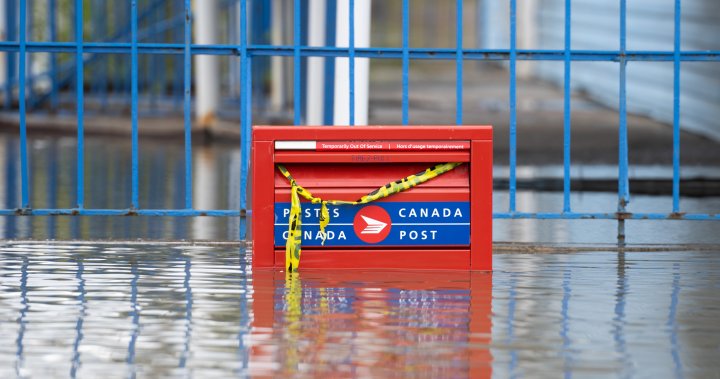Canada Post is continuing to bleed money amid fundamental shifts in mail delivery, pushing the Crown corporation to signal that something will have to change if it wants to right the ship.
Canada Post reported a $748-million annual loss before taxes for 2023 on Friday, the postal service’s sixth consecutive year in the red.
In a statement accompanying the result, the organization was blunt about the challenges facing a modern-day mail carrier.
Canada Post noted that back in 2006, the average Canadian household was receiving some seven letters a week; that’s down to just two in 2023, following the rapid rise of email and other forms of internet communication.
Alongside a decline in this transactional mail segment, Canada Post also posted revenue declines in its parcel and direct marketing services in 2023.
Parcel delivery had been a saving grace for the mail service in recent years amid a boom in Canadians shopping online, particularly in the pandemic.
But Canada Post’s share of that market is eroding too: where it once delivered nearly two-thirds of parcels pre-pandemic, the rise of new competitors in the space meant the Crown corporation handled less than a third of all packages last year.
In a bid to boost revenue flows heading into the postal service’s coffers, Canada Post confirmed a previous announcement Monday that the cost of a single stamp would rise seven cents to just under a dollar when bought in a booklet.
But that move – the third price hike on stamps in roughly a decade – will not be enough to avoid the need for structural changes to keep Canada Post’s operations viable, according to experts who spoke to Global News and the mail carrier itself.
“Canadians understand our business model must change. They can see it in their mailbox,” president and CEO Doug Ettinger said in a statement on Friday.
“An operating model designed to deliver nearly 5.5 billion letters in 2006 cannot be sustained on the 2.2 billion letters we delivered last year.”
Despite the inroads from other package delivery services, Canada Post spokesperson Jon Hamilton tells Global News the Crown corporation continues to see parcels as a growth market for mail.
“We expect e-commerce in Canada to double over the next 10 years. We just need to be better positioned to get as much of that growth as possible,” Hamilton says.
Canada Post has a sizable network of mail carriers and post offices to compete with the likes of Amazon, Purolator and FedEx, but Hamilton points to the Crown corporation’s mandate as needing an update.
He says the legislation governing Canada Post needs greater “flexibility” for the provider to be able to better manage its flow of operations. That could mean prioritizing some mail but also putting less-urgent deliveries on a “slower track,” he says.
Financial news and insights
delivered to your email every Saturday.
“A lot of that is covered by rules that were put in place in 2009 when Netflix was still delivering DVDs in the mail,” Hamilton says.
Another challenge facing Canada Post is the rapid growth of the Canadian population. Hamilton says the mail service adds roughly 200,000 standalone addresses to its network in a given year, ratcheting up the costs of delivery without significantly boosting revenues.
Canada Post sees a “housing boom” coming amid efforts from all levels of government to scale up the pace of homebuilding in the country, a challenge that Hamilton reiterates will require greater “flexibility” for the corporation to tackle.
Marvin Ryder, associate professor at McMaster University’s DeGroote School of Business, agrees that the frequency of mail delivery might need to change in the face of declining mail volumes.
He tells Global News that an every-other-day delivery system could see Canada Post’s costs cut nearly in half for a modest decline in service.
Maintaining a daily delivery service to every address in Canada is an expensive endeavour, and raising the cost of postage is a short-term solution that could end up driving down business even more in the long run as people turn to cheaper electronic options, Ryder argues.
“In more urban or suburban areas, the introduction of more super mailboxes or moving to every-other-day delivery, that would be the least painful way to keep the service going and yet at the same time reduce the costs of its operations,” he says.
Jean-Yves Duclos, the federal minister responsible for Canada Post, was asked in Ottawa Tuesday whether the government would amend legislation to remove the mandate for daily mail delivery.
While Duclos said it was an “option” being considered by Canada Post, he did not weigh in on whether the Liberal government would make that change. He acknowledged the changing landscape for mail delivery in Canada but said the government is waiting to see a new model from the Crown corporation to boost revenues and save on costs.
Global News asked Hamilton if proposals like an expansion of community mailboxes were on the table in Canada Post’s turnaround strategy, but he said it was premature to mention “very specific measures.”
Canada Post is also in the midst of negotiating a new contract with the Canadian Union of Postal Workers. Global News reached out to the CUPW to ask whether there are fears of layoffs in response to Canada Post’s financial concerns but was pointed instead to a statement released Tuesday from the union.
In that release, the CUPW acknowledged that “the track Canada Post is currently on isn’t working.”
The union pushed for Canada Post’s mandate to evolve beyond mail delivery, as postal services in other parts of the world have done to remain relevant amid the decline in transactional mail.
Some examples included a service Japan offers that checks in on older adults and reports back to family members for a small monthly fee, or other parts of the world like France where the postal service also operates as a bank.
Ryder says Canada Post, with its numerous post offices in centralized locations, could take on services like passport renewals or banking or insurance operations – particularly in remote or rural areas that struggle to attract private service providers.
But he notes that such a move from a Crown corporation would immediately spook the private market, which would complain about a state entity competing in established markets.
Canada Post is currently not directly funded by the Canadian government, with a mandate to run and fund its operations independently.
But with the clock ticking on Canada Post’s coffers, Hamilton says the corporation has been in talks with Ottawa about how to ensure service delivery isn’t disrupted.
“We’re working with the government on some short-term measures to give us some breathing space in terms of financing,” he says.
The 2024 federal budget, tabled last month, said that the federal government would be looking at Canada Post’s portfolio of more than 1,700 post offices as prospects for housing redevelopment in the years to come.
Ryder says he would prefer to see the federal government expand Canada Post’s mandate and let it remain a viable, independent business that provides critical services to Canadians rather than hand out direct subsidies to the organization.
Glen Hodgson, a senior fellow at the C.D. Howe Institute who has analyzed Canada’s Crown corporations in a 2021 report, tells Global News that Canada Post is likely going through an “existential period” to try to figure out what its role will be going forward.
Hodgson says he would not expect a Canada Post-run startup banking service, for example, would get much traction in Canada’s already well-established financial system.
But Canada Post would not be the first or only Crown corporation to receive a government subsidy to continue to do a job under the costs of actually providing that service, he notes.
Via Rail, for example, receives regular government subsidies to be able to offer relatively affordable rail travel across the country, he says.
If Canada Post is unable to salvage its mail delivery business “we may well be entering a world where a subsidy model becomes a real option,” he says.
“I think you end up having to think about the basics, about how to contain costs, to what extent can you raise prices and the market will absorb that. And at the end of the day, you may have to put your hand out and ask the taxpayer for support the way we do with the rail,” Hodgson says.
“It’s a very Canadian model. You try everything and then ask for a subsidy.”




